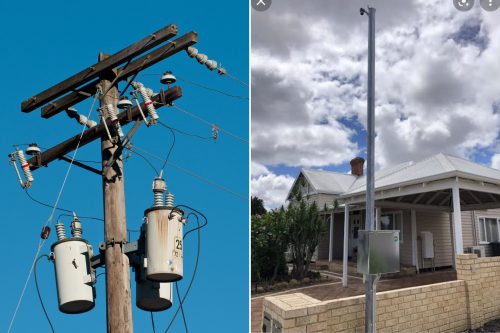Wooden power poles are everywhere. These timber poles carry the wires that keep us connected. But as times change, so do our choices. Now, more and more of us are choosing steel power poles. This shift isn’t just about new vs. old. It’s about adapting to our evolving needs, technologies, and values.
Let’s explore the pros and cons of wooden and steel power poles so you can make an informed decision about your upcoming project.
Pros and Cons of Wooden Power Poles
Wooden poles have been a staple in our landscapes for decades. Here are the pros and cons:
Benefits of Wooden Power Poles
Flexibility in Sizes
Wooden power poles offer a great advantage in terms of size and versatility. Timber provides a wide range of options for pole length and diameter, which enables you to customise the size of the pole according to your project’s specific requirements. This flexibility can be particularly beneficial in areas with unique geographical or environmental challenges.
Timber Aesthetic
Wooden power poles are often used in rural or scenic areas where maintaining a natural look is important. They blend seamlessly into the landscape, providing a warm and traditional aesthetic that adds to the visual appeal of the locality.
Durability and Maintenance
Wooden power poles can have a surprisingly long lifespan and often require less maintenance than expected. Treated timber is mostly resistant to rot, pests, and the elements. While upkeep is still necessary, the frequency and intensity of care can be less than that of other materials.
Drawbacks of Wooden Power Poles
While wooden power poles have their advantages, they also come with several drawbacks:
Heavy Weight
Wooden power poles are heavy. This not only makes transportation more challenging but also complicates the installation process. The effort required to manoeuvre and erect these poles can increase overall project costs.
Initial and Ongoing Expenses
Wooden poles are more expensive to install and have higher initial purchase costs. While they may not need maintenance as frequently as some materials, when issues arise, they can be costly to address.
Moisture and Rot Concerns
Wooden poles are not well-suited to areas close to groundwater or those with high moisture levels. After rainfall, timber can remain damp for extended periods, creating an ideal environment for rot. This can shorten a pole’s lifespan.
Termite Vulnerability
Termites pose a real threat to wooden structures in Australia. These pests can silently compromise a pole’s integrity, leading to safety risks and unexpected failures.
Pros and Cons of Steel Power Poles
As we move towards more sustainable and efficient infrastructure solutions, steel power poles are increasingly becoming the preferred choice for new electrical and communication lines.
Here are the pros:
Benefits of Steel Power Poles
Environmental Advantage
Steel power poles are a great choice for those who prioritise environmental sustainability. Unlike wooden poles, steel poles don’t require the cutting down of trees during production. By choosing steel, we can actively contribute to the preservation of forests and the ecosystems they support.
Modern Look
With a sleek and modern appearance, steel power poles complement urban landscapes. Their design and finish can blend into a variety of property styles.
Ease of Installation
Steel poles are generally lighter than their wooden counterparts, making them easier and less expensive to transport and install. This ensures fast project completions and reduced disruption to the surrounding area.
Cost-Effectiveness
Purchasing, installing, and repairing steel poles can be cheaper than wooden poles. Their durability and lower maintenance requirements contribute to a lower total cost of ownership over the lifespan of the pole. This makes steel an economically attractive option for many projects.
Termite-Proof
Unlike wooden poles, steel poles are impervious to termite damage. This resistance to pests eliminates the need for chemical treatments and frequent inspections.
Customisable Appearance
Steel poles can be powder coated in various colours to match the local environment or adhere to specific design requirements.
Reduced Obstruction
Due to their slimmer profile, steel poles are less obstructive and can be more easily integrated into existing spaces. Their smaller footprint allows for more efficient land use, particularly in densely populated or environmentally sensitive areas.
Drawbacks of Steel Power Poles
While steel power poles offer many benefits, there are specific conditions under which their performance may be less than ideal.
Corrosion in Salty Environments
Steel can be vulnerable in coastal regions. The salty air can accelerate the corrosion process, reducing the pole’s lifespan and necessitating more frequent inspections and maintenance to prevent structural failure. However, nowadays there are plenty of different surface finishes available that protect against coastal corrosion.
You Can’t Get The Wood Look
While steel poles can be powder coated in various colours to match the environment or adhere to specific design requirements, some may find their appearance less appealing compared to the natural look of wooden poles, especially in rural or scenic areas where aesthetics are important.
What’s best?
The best power pole is the one that’s best for your unique circumstances! Ultimately, the choice between wooden and steel power poles depends on various factors such as budget, environmental considerations, aesthetic preferences, and specific project requirements. Each material has its advantages and drawbacks, so weigh them carefully before making a decision.
Get Personalised Advice From G&S Industries
At G&S Industries, we specialise in bespoke steel pole fabrication. In fact, we manufacture intermediate power connection poles which are erected between the council’s wooden power pole line and a house. If you’re in need of new steel poles for your upcoming project, don’t hesitate to get in contact with our friendly team today!

